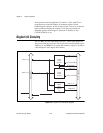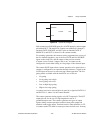
Chapter 3 Theory of Operation
AT-MIO-16X User Manual 3-28
©
National Instruments Corporation
counter applications, the counter reloads from an internal register when
it reaches TC. In TC pulse output mode, the counter generates a pulse
during the cycle that it reaches TC and reloads. In TC toggle output
mode, the counter output changes state after it reaches TC and reloads.
In addition, the counters can be configured for positive logic output or
negative (inverted) logic output for a total of four possible output
signals generated for one timing mode.
The GATE and OUT pins for Counters 1, 2, and 5 and SOURCE pins
for Counters 1 and 5 of the onboard Am9513A are located on the
AT-MIO-16X I/O connector. A falling edge signal on the EXTTRIG*
pin of the I/O connector or writing to the STARTDAQ register during
a data acquisition sequence sets the flip-flop output signal connected to
the GATE4 input of the Am9513A and can be used as an additional gate
input. This mode is also used in the pretrigger data acquisition mode.
The flip-flop output connected to GATE4 is cleared when the sample
counter reaches TC, when an overflow or overrun occurs, or when the
DAQ Clear Register is written to. An overrun is defined as an error
generated when the ADC cannot keep up with its programmed
conversion speed.
The Am9513A SOURCE5 pin is connected to the AT-MIO-16X RTSI
switch, which means that a signal from the RTSI trigger bus can be used
as a counting source for the Am9513A counters.
The Am9513A OUT1, OUT2, OUT3 (EXTCONV*), and OUT5 pins
can be used in several different ways. If waveform generation is
enabled, an active low pulse on the output of the counter selected
through the RTSI switch updates the analog output on the two DACs.
The counter outputs can also be used to trigger interrupt and DMA
requests. If the proper mode is selected in Command Register 2, an
interrupt or DMA request occurs when a falling edge signal is detected
on the selected DAC update signal.
Counters 3 and 4 of the Am9513A are dedicated to data acquisition
timing, and therefore are not available for general-purpose timing
applications. Signals generated at OUT3 and OUT4 are sent to the
data acquisition timing circuitry. GATE3 is controlled by the data
acquisition timing circuitry. OUT3 is internally connected to
EXTCONV* so that when internal data acquisition sequences (OUT3)
are used, EXTCONV* should be disconnected or tristated. For the same
reason, if external data acquisition sequences (EXTCONV*) are used,
OUT3 should be programmed to the high-impedance state.


















